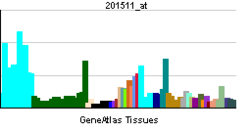AAMP (gene)
Angio-associated, migratory cell protein, also known as AAMP, is a protein which in humans is encoded by the AAMP gene.[3]
Function
The gene product is an immunoglobulin-type protein. It is found to be expressed strongly in endothelial cells, cytotrophoblasts, and poorly differentiated colon adenocarcinoma cells found in lymphatics.
The protein contains a WD40 domain and a heparin-binding domain which mediates heparin-sensitive cell adhesion.[3]
References
External links
Further reading
- Beckner ME, Krutzsch HC, Stracke ML, et al. (1995). "Identification of a new immunoglobulin superfamily protein expressed in blood vessels with a heparin-binding consensus sequence.". Cancer Res. 55 (10): 2140–9. PMID 7743515.
- Maruyama K, Sugano S (1994). "Oligo-capping: a simple method to replace the cap structure of eukaryotic mRNAs with oligoribonucleotides.". Gene. 138 (1–2): 171–4. doi:10.1016/0378-1119(94)90802-8. PMID 8125298.
- Beckner ME, Krutzsch HC, Klipstein S, et al. (1996). "AAMP, a newly identified protein, shares a common epitope with alpha-actinin and a fast skeletal muscle fiber protein.". Exp. Cell Res. 225 (2): 306–14. doi:10.1006/excr.1996.0181. PMID 8660919.
- Suzuki Y, Yoshitomo-Nakagawa K, Maruyama K, et al. (1997). "Construction and characterization of a full length-enriched and a 5'-end-enriched cDNA library.". Gene. 200 (1–2): 149–56. doi:10.1016/S0378-1119(97)00411-3. PMID 9373149.
- Beckner ME, Peterson VA, Moul DE (1999). "Angio-associated migratory cell protein is expressed as an extracellular protein by blood-vessel-associated mesenchymal cells.". Microvasc. Res. 57 (3): 347–52. doi:10.1006/mvre.1999.2144. PMID 10329261.
- Beckner ME, Jagannathan S, Peterson VA (2002). "Extracellular angio-associated migratory cell protein plays a positive role in angiogenesis and is regulated by astrocytes in coculture.". Microvasc. Res. 63 (3): 259–69. doi:10.1006/mvre.2001.2384. PMID 11969303.
- Strausberg RL, Feingold EA, Grouse LH, et al. (2003). "Generation and initial analysis of more than 15,000 full-length human and mouse cDNA sequences.". Proc. Natl. Acad. Sci. U.S.A. 99 (26): 16899–903. doi:10.1073/pnas.242603899. PMC 139241
 . PMID 12477932.
. PMID 12477932.
- Brandenberger R, Wei H, Zhang S, et al. (2005). "Transcriptome characterization elucidates signaling networks that control human ES cell growth and differentiation.". Nat. Biotechnol. 22 (6): 707–16. doi:10.1038/nbt971. PMID 15146197.
- Gerhard DS, Wagner L, Feingold EA, et al. (2004). "The status, quality, and expansion of the NIH full-length cDNA project: the Mammalian Gene Collection (MGC).". Genome Res. 14 (10B): 2121–7. doi:10.1101/gr.2596504. PMC 528928
 . PMID 15489334.
. PMID 15489334.
- Kimura K, Wakamatsu A, Suzuki Y, et al. (2006). "Diversification of transcriptional modulation: large-scale identification and characterization of putative alternative promoters of human genes.". Genome Res. 16 (1): 55–65. doi:10.1101/gr.4039406. PMC 1356129
 . PMID 16344560.
. PMID 16344560.

 . PMID 12477932.
. PMID 12477932. . PMID 15489334.
. PMID 15489334. . PMID 16344560.
. PMID 16344560.